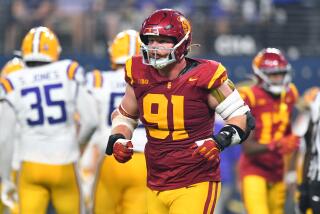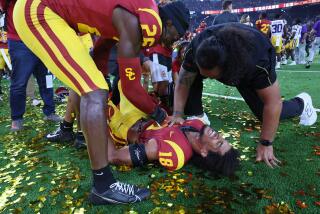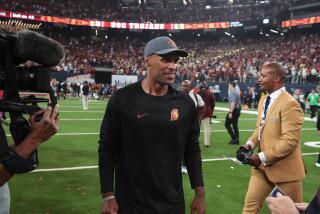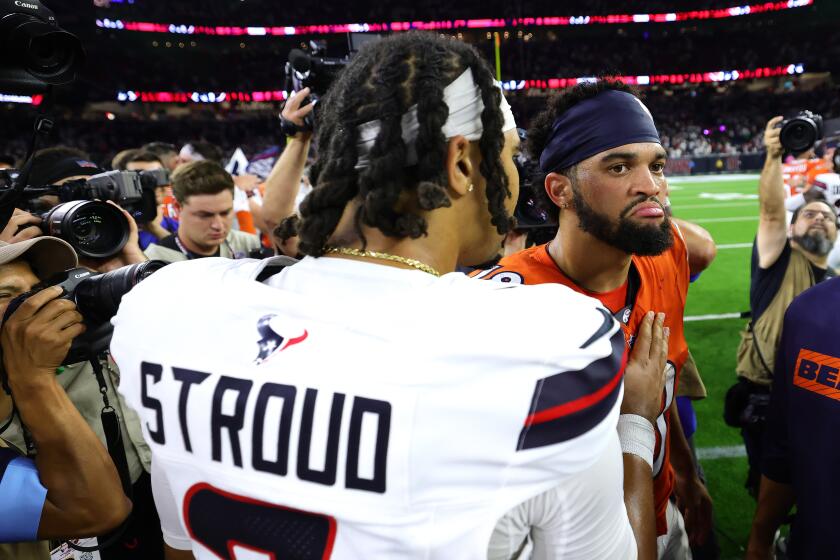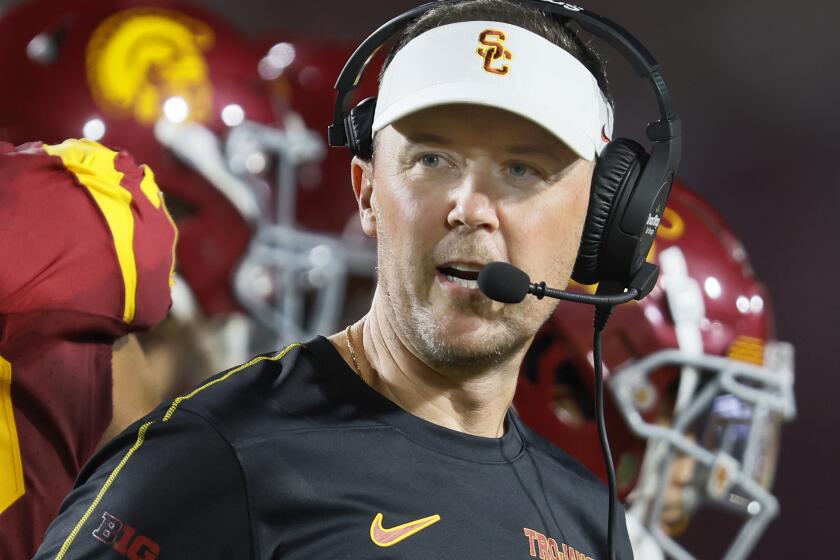USC’s ‘predator’ position survives a wave of injuries
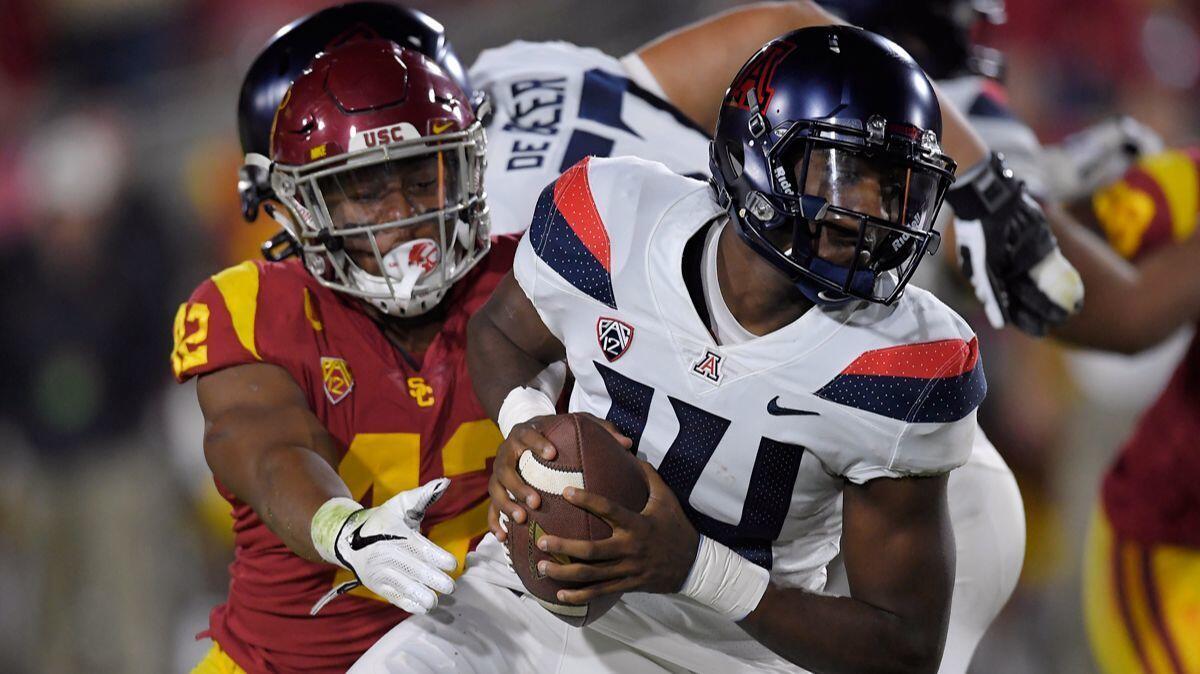
USC linebackers coach Johnny Nansen approached Jordan Iosefa during the second quarter of USC’s game against Notre Dame with an unusual request.
Iosefa is an inside linebacker. Every single practice repetition he’d taken this season was on the inside. But USC was getting hammered on the outside.
How about giving us some help there, Nansen said.
“I’m just thankful to have their trust,” Iosefa said. “They threw me in in the middle of the Notre Dame game. I’m like, ‘Yeah, let’s just do it. Let’s go.’ ”
Iosefa became the third Trojan to play significant snaps at the “predator” linebacker position. In last week’s game against Arizona, Iosefa’s second time starting at the position, he had eight tackles, one sack and a forced fumble. Coach Clay Helton called it an “exceptional job.”
During a season of injuries, USC has had particularly foul luck at the predator position. Yet, even after injuries to the starter, Porter Gustin, and his supremely competent replacement, Christian Rector, USC hasn’t experienced much drop-off.
The engine behind USC’s bottomless bowl of outside linebackers is a change brought by defensive coordinator Clancy Pendergast that has allowed USC to compete against the Pac-12 Conference’s spread-heavy offenses. It also brought in the flexible, athletic linebackers that have kept USC afloat despite the injuries.
Pendergast formed his 5-2 defense while with the Arizona Cardinals — and the name didn’t really signify five down linemen and two linebackers. The Cardinals coach, Dennis Green, wanted Pendergast to run a 3-4 scheme that mixed one common element of the 4-3, and it needed a new name.
“You’ve got to come up with seven,” Pendergast said. “So I came up with 5-2.”
That defense birthed the “predator,” essentially a defensive end that stands upright.
That little change makes a big difference. A defender is only as good as his vision, particularly against the spread, zone-read teams USC faces heavily that requires more athleticism than brute force. And a defender can see much better from six feet off the ground than one foot. The role shifts slightly when USC goes to nickel, its preferred set against most Pac-12 teams, but the fundamental concepts remain the same.
When Pendergast arrived at USC, Nansen said, the Trojans shifted what they looked for in outside linebacker recruits. They valued athleticism over everything. They preferred either players like Gustin — smaller, faster athletes they could beef up in the weight room — or defensive ends like Rector, big men who could move.
Rector fit the mold particularly well. He played end in at Los Angeles Loyola High, and also played tight end and receiver.
“He’s a big guy,” Loyola coach Rick Pedroarias said. “He was a big target.”
His versatility helped him see the field at USC. When Gustin was injured, Rector was a natural fit. Soon, despite not starting early in the season, he led the Pac-12 in sacks.
Before USC played Arizona, Rector fractured a hand in practice. He could return in a limited role this week, Helton said. But in the meantime, USC needed another option. It turned to Iosefa.
Iosefa played in a similar 5-2 system at St. Louis School in Honolulu. His coach there, Cal Lee, said Iosefa was an intelligent player. He picked up every position so naturally.
USC quickly shuffled him to the inside, one of several positional changes that USC’s defense has made.
“A lot of people are like, ‘What are you guys doing?’” Nansen said. “Well, when you have kids that understand football and understand the system and we do a great job of teaching the system, it makes it so much easier.”
Helton said that Iosefa was the blueprint of what USC looks for in a linebacker.
“We thought we were getting the best of both worlds because he could be an interior linebacker or an edge player in Clancy’s system,” Helton said.
Iosefa was on Helton’s mind when USC signed another linebacker, Levi Jones, this offseason. One day soon, USC might find itself in another pinch. Jones will be ready, Iosefa said, to become the latest option to plug in and reload.
Quick hits
The graduation success rate for the USC athletic department overall was 86% in 2017, the school’s highest figure. ... Helton expects running back Vavae Malepeai (knee) and tight end Josh Falo (foot) to play Saturday.
Follow Zach Helfand on Twitter @zhelfand
More to Read
Go beyond the scoreboard
Get the latest on L.A.'s teams in the daily Sports Report newsletter.
You may occasionally receive promotional content from the Los Angeles Times.
